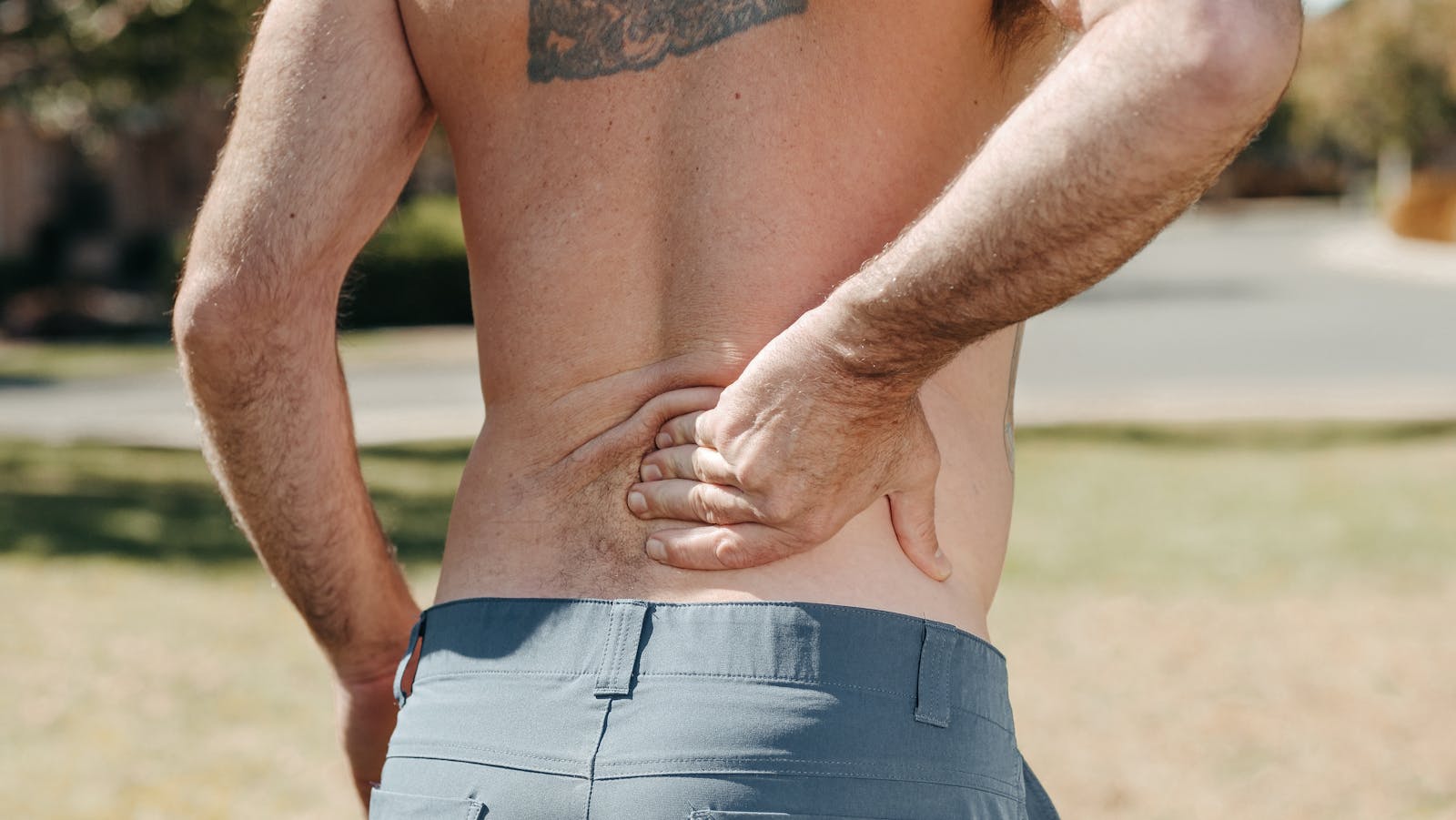In the domain of physical health, a pulled back muscle, especially on the right side, can be a significant source of discomfort and distress. The array of symptoms may range from a sharp, sudden pain during movements such as bending or lifting, to persistent throbbing that worsens with an upright posture. Additionally, additional indicators such as muscle spasms, stiffness, and localized swelling can further complicate the situation. As we explore this discussion, let’s delve into the nuances of these symptoms, the critical role of timely medical intervention, and the possible treatment avenues for such an ailment.
Understanding Pulled Back Muscles
What exactly does it mean to have a pulled muscle in your back, particularly on the right side? A pulled muscle, also known as a muscle strain, is caused by an overstretching or tearing of the muscle fibers. It often results in discomfort, pain, and limited mobility in the affected area. In the context of muscle health importance, such conditions can disrupt daily activities and overall well-being.
Understanding the anatomy of the back reveals that it’s composed of numerous muscles working in unison. A strain in any of these muscles, including those on the right side, can cause significant discomfort. Depending on the severity of the strain, it can limit the range of motion and impact the quality of life.
Prevention strategies for a pulled back muscle involve maintaining good muscle health. This includes regular exercise to strengthen the back muscles, proper lifting techniques to avoid undue stress on the back, and maintaining a healthy weight to reduce pressure on the back muscles. It is also vital to warm-up before engaging in any strenuous physical activity to prepare the muscles and reduce the risk of injury. By adopting these prevention strategies, one can greatly reduce the likelihood of pulling a back muscle.
Common Causes of Pulled Muscles
How does one typically end up with a pulled muscle, particularly in the back? The answer lies in four common causes:
- Overexertion or strain: This is the most common cause of pulled back muscles. It typically happens when one overuses a muscle during intense physical activity, leading to muscle overuse consequences.
- Incorrect posture: Poor posture, especially when lifting heavy objects or during exercise, can place undue stress on the back muscles, leading to strains and pulls.
- Lack of conditioning: Muscles that are weak or inflexible due to lack of exercise or sedentary lifestyle are more prone to injury. Regular physical activity can help strengthen these muscles, demonstrating the preventative measures effectiveness.
- Trauma or injury: A sudden impact from a fall, accident, or contact sports can cause a muscle to stretch beyond its normal capacity, resulting in a pull.
Understanding these causes can aid in prevention, and early detection can help mitigate the severity of a pulled muscle. In the next section, we’ll discuss the initial symptoms to watch for when dealing with a potential pulled back muscle.
Initial Symptoms to Watch For
Recognizing the onset of a pulled back muscle, particularly on the right side, often begins with noting several distinctive symptoms that serve as early indicators of this common musculoskeletal issue. It’s important to observe the duration and triggers of these symptoms, as these factors can provide vital insights about the severity of the condition.
Symptom duration is a key aspect to take into account. Acute discomfort that lasts for a few days can indicate a minor muscle strain. However, if the pain persists beyond a week, it might suggest a more serious muscle pull or tear. It’s also essential to monitor pain fluctuations during different activities, providing insights into potential pain triggers.
Pain triggers could include particular movements such as bending, twisting, or lifting heavy objects. A sudden sharp pain on the right side of the back during these activities is a typical sign of a pulled muscle. Additionally, persistent discomfort or stiffness in the right back area during normal daily routines can also be a symptom of this condition. It’s important to seek medical attention if these symptoms persist, to ensure appropriate treatment and prevent further complications.
Pain Characteristics When Standing
The manifestation of pain during upright postures can often be a telling sign of a pulled muscle in the right side of the back. This discomfort typically presents as a sharp or burning sensation, potentially signifying an underlying muscle strain or sprain.
The following are four key characteristics that you might experience when standing, which can help in identifying a pulled back muscle:
- Sudden Onset: The pain often starts abruptly, typically after an activity that puts strain on the back muscles.
- Pain Intensification: Certain actions like bending or twisting may trigger or intensify the pain.
- Posture Effects: Maintaining an upright posture for extended periods of time can exacerbate the discomfort.
- Pain Localization: The pain is usually confined to the right side of the back and does not spread to other areas.
While these symptoms generally indicate a pulled back muscle, they can also be associated with other health conditions. Therefore, it’s important to seek medical advice if you experience persistent or severe back pain.
Understanding these pain triggers and posture effects can enable you to manage your symptoms effectively and prevent further injury.
Pain Characteristics When Sitting
Shifting your attention to the seated position, it’s worth noting that the characteristics of pain experienced when sitting can provide further insights into a possible pulled muscle on the right side of the back. A sedentary lifestyle often exacerbates this type of injury, as long hours of sitting can strain the already damaged muscle tissues, intensifying the pain.
The effects of a sedentary lifestyle, such as physical inactivity and prolonged periods of sitting, can lead to muscle imbalances and poor posture, further aggravating the pain from a pulled back muscle. The discomfort may range from a dull ache to a sharp, stabbing sensation, often worsening while moving from a sitting to a standing position.
In contrast, posture correction methods can be an effective way to alleviate this pain. Implementing practices such as maintaining a neutral spine, sitting upright with the shoulders pulled back, and taking regular breaks to stand or walk, can help support the back muscles and alleviate discomfort. Additionally, using ergonomic furniture designed to support good posture can also contribute positively.
While sitting may provide temporary relief from standing, monitoring pain characteristics in this position can be important in diagnosing and managing a pulled muscle on the right side of the back.
Pain Characteristics When Lying Down
When considering the symptoms of a pulled back muscle on the right side, it is important to examine the pain characteristics experienced during rest periods, specifically while lying down. Two key factors to be discussed are the intensity of discomfort during the night and the impact of different lying positions on this pain. Understanding these aspects can provide a detailed view of the condition and guide effective management strategies.
Nighttime Discomfort Intensity
Nighttime can greatly intensify the discomfort experienced from a pulled back muscle on the right side, especially while lying down. This can result from various factors:
- Inadequate sleeping positions can exacerbate pain. The wrong posture might put more pressure on the affected area, increasing discomfort.
- Nocturnal dehydration may also contribute to aggravated pain. Reduced fluid intake at night can lead to muscle cramps, further straining the pulled muscle.
- The body’s natural pain suppression mechanisms become less active during sleep, which can amplify the pain sensation.
- Finally, the quiet and stillness of the night can make you more aware of your pain, intensifying the perceived discomfort.
Understanding these factors can help manage nighttime discomfort from a pulled back muscle.
Position Impact on Pain
The influence of body position, particularly when lying down, on pain intensity is an important aspect to contemplate in managing discomfort from a pulled back muscle on the right side. The posture effects, or how one positions oneself, can greatly impact the perceived pain levels. Certain postures can act as pain triggers, exacerbating discomfort. For instance, lying in a supine position might stretch or compress the affected muscle, resulting in increased pain. Conversely, a well-aligned side-lying posture can offer pain relief by reducing pressure on the injured area. Detailed knowledge of these posture effects is vital in optimizing pain management strategies. Understanding the relationship between body positioning and pain intensity can significantly improve the quality of life for individuals suffering from a pulled back muscle.
How Movement Affects the Pain
Understanding the impact of various movements on the intensity of pain is essential in identifying the symptoms of a pulled back muscle on the right side. This is particularly crucial when examining how inflammation influences the pain and the potential exercise repercussions. Here are four key aspects to take into account:
- Inflammation influence: The swelling around the injured muscle often worsens the pain. Simple movements such as lifting items or bending can escalate inflammation, causing spikes in discomfort.
- Exercise repercussions: Engaging in strenuous physical activities without proper recovery may result in re-injury or increased pain. It is crucial to rest and allow the muscle to heal.
- Pain during specific movements: Certain actions, like twisting or bending, can significantly amplify the pain in the affected area. If these movements cause sharp pain, it’s a strong indicator of a pulled muscle.
- Intense pain during rest: Even without movement, intense pain can sometimes be felt. This is a possible sign that the muscle injury is severe, requiring immediate medical attention.
Understanding these elements will aid in identifying a pulled back muscle and potentially prevent further damage.
Accompanying Symptoms to Note
In addition to recognizing the role of movement in pain intensity, it’s equally important to be aware of other symptoms that often accompany a pulled back muscle on the right side. An individual may experience persistent discomfort, even when at rest, and the symptom duration may vary widely, from a few days to several weeks. The pain often intensifies with specific actions or movements, known as pain triggers, which can include bending, lifting, twisting, or even coughing and sneezing.
Apart from pain, other accompanying symptoms can include muscle spasms, stiffness, and swelling in the affected area. The individual may also notice a decreased range of motion in the back, making it difficult to perform daily activities. In some cases, the pain may radiate downwards, causing discomfort in the buttocks or legs.
If these symptoms persist or worsen, it’s important to seek medical attention to prevent further complications. Effective management of a pulled back muscle involves understanding the nature of the pain, its triggers, and symptom duration. It’s also essential to note any additional symptoms that may indicate a more serious injury. Therefore, a thorough understanding of these aspects can inform a more accurate diagnosis and treatment plan.

Differences Between Left and Right Side
When examining a pulled back muscle, it’s important to distinguish between the left and right sides as each can present unique characteristics. Variations in pain patterns may be observed based on the side affected, which may also influence mobility. We will now explore these differences to provide a thorough understanding of the condition.
Pain Pattern Variations
Remarkably, the pain patterns associated with a pulled muscle can vary greatly between the left and right sides of the back. This variation is largely due to the complex muscle anatomy of the back, which consists of multiple layers and numerous muscles working in unison.
- Dominant Side Impact: Typically, the dominant side experiences more strain, leading to different pain patterns.
- Muscle Anatomy Perspective: The interplay of different muscles can result in unique pain patterns on each side.
- Injury Prevention: Understanding these pain patterns can aid in early detection and prevention of further injury.
- Individual Variations: Everyone’s body is unique, and so are their pain pattern variations.
Understanding these variations can prove instrumental in tailoring effective recovery plans and preventing future injuries.
Impact on Mobility
Exploring the intricate maze of mobility issues arising from a pulled back muscle on the right side illuminates stark contrasts in comparison to the left side. A right-sided injury often necessitates the usage of mobility aids due to the dominant role the right side plays in activities such as walking and driving for most individuals. This reliance on assistive devices can lead to an altered gait pattern, further impacting posture. A person may lean more to their unaffected side, causing an imbalance in their body alignment. In contrast, a left-sided muscle pull may have less impact on mobility, particularly for right-handed individuals. Regardless of the side, a pulled back muscle can have a significant impact on one’s mobility, highlighting the importance of appropriate treatment and rehabilitation.
Importance of Immediate Medical Attention
In the event of a pulled muscle in the right side of the back, prompt medical attention can play an important role in mitigating pain and preventing further complications. Quick emergency response times are essential in these situations, as they can greatly reduce the duration and severity of pain. The effectiveness of medication, particularly pain relievers and muscle relaxants, is often enhanced when administered promptly.
Immediate medical attention is essential due to a number of reasons:
- Reduced Pain Duration: Rapid response and treatment can lessen the period of pain, providing relief to the patient.
- Prevention of Further Injury: Immediate medical attention allows healthcare professionals to assess the extent of the injury and take necessary measures to prevent further damage.
- Effective Medication Use: Early administration of certain medications can help reduce inflammation and muscle spasms, improving patient comfort.
- Early Rehabilitation: Starting physiotherapy and other rehabilitative measures as soon as possible can help restore mobility and function to the injured area, reducing the risk of long-term disability.
Treatment Options for Pulled Back Muscles
When dealing with a pulled back muscle, particularly on the right side, it is important to explore various treatment options to guarantee the best possible recovery. These options may include understanding pain management, exploring the role of physical therapy, and considering surgery as a last resort. Each of these strategies offers unique benefits and potential challenges that should be carefully examined.
Understanding Pain Management
Finding the myriad options for pain management can be challenging, particularly with a condition as common as a pulled back muscle on the right side. However, understanding the diverse approaches can greatly aid in alleviating discomfort.
- Mindfulness Techniques: Mindfulness is a powerful tool for pain management. It encourages a focus on the present moment, reducing stress and promoting relaxation, which can ease muscle tension.
- Drug Interactions: Be mindful of potential interactions if you’re taking multiple medications. Always consult your healthcare provider to guarantee safety.
- Over-the-counter Analgesics: These can provide temporary relief for mild to moderate pain.
- Prescribed Medications: For severe pain, your healthcare provider may prescribe stronger medications. Always take them as directed to avoid misuse or addiction.
Role of Physical Therapy
Physical therapy plays a pivotal role in the treatment and recovery from a pulled back muscle, offering a range of techniques that can promote healing, restore function, and prevent future injuries. Therapeutic exercises are an integral part of this process, designed to gradually restore range of motion and strength. They can include stretching, strengthening, and low-impact aerobic conditioning. The recovery timeline from a pulled back muscle is variable and depends largely on the severity of the injury, the patient’s overall health, and their commitment to the therapy program. However, with consistent therapy sessions, patients can expect a gradual decrease in pain and improvements in mobility, often within a few weeks. Physical therapy also provides strategies for pain management and injury prevention, ensuring long-term back health.
Surgery: Last Resort Option
In severe cases where non-surgical treatments fail to provide relief, surgery may become a last-resort option for patients suffering from a pulled back muscle on the right side. However, this decision is not taken lightly. A thorough surgical risks analysis is conducted to weigh the potential benefits against the possible complications.
- Surgical Risks: Surgical risks may include infection, bleeding, or nerve damage.
- Post-Surgery Recovery: The recovery period can be lengthy, requiring physical therapy and pain management strategies.
- Emotional Impact: The emotional toll of surgery can be significant, affecting the patient’s overall well-being.
- Cost Considerations: Surgery is often the most costly treatment option.
Thus, while surgery can provide relief, it’s important to carefully contemplate these factors.
Frequently Asked Questions
Can Specific Exercises Help Prevent Pulling a Back Muscle?
Yes, specific exercises can certainly help prevent a back muscle pull. Exercise benefits include increased flexibility and muscle strengthening, both of which are essential for maintaining a healthy back and preventing muscle strains or pulls.
How Long Does a Pulled Back Muscle Take to Heal?
The healing duration for a pulled back muscle varies, typically between 2-6 weeks. Effective pain management techniques and a recovery diet rich in protein can promote healing and expedite recovery.
Are There Any Lifestyle Changes That Can Reduce the Risk of Muscle Pulls?
Yes, lifestyle changes can reduce the risk of muscle pulls. Regular exercise, proper stretching techniques, maintaining a healthy weight, and dietary impact can all contribute. Also, stress management can prevent muscle tension which can lead to pulls.
Are Pulled Back Muscles More Common in Certain Age Groups?
Pulled back muscles are not more common in specific age groups. However, factors such as gender susceptibility and occupational risks can influence the likelihood of experiencing this condition. Regular stretching and exercise can mitigate these risks.
Does Cold Weather Affect the Likelihood of Pulling a Back Muscle?
Cold weather’s impact on muscle contraction dynamics can increase the likelihood of pulling a back muscle. Low temperatures cause muscles to contract and stiffen, reducing flexibility and making them more susceptible to injury.


